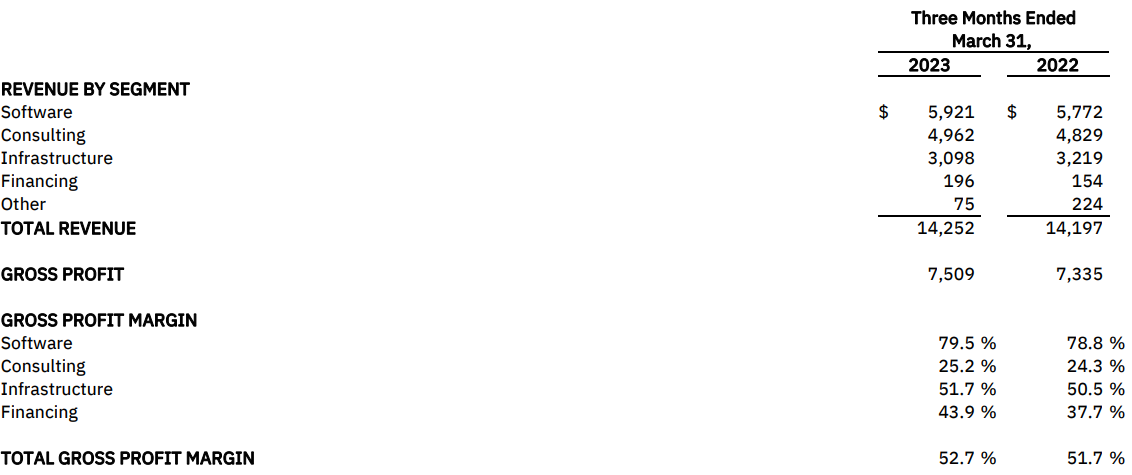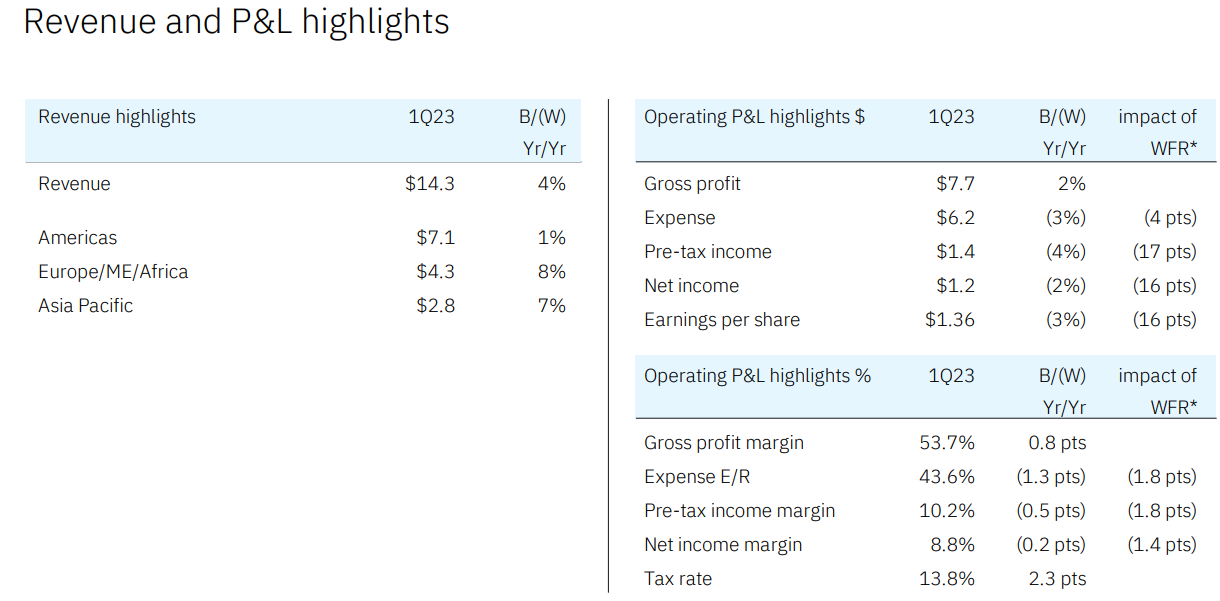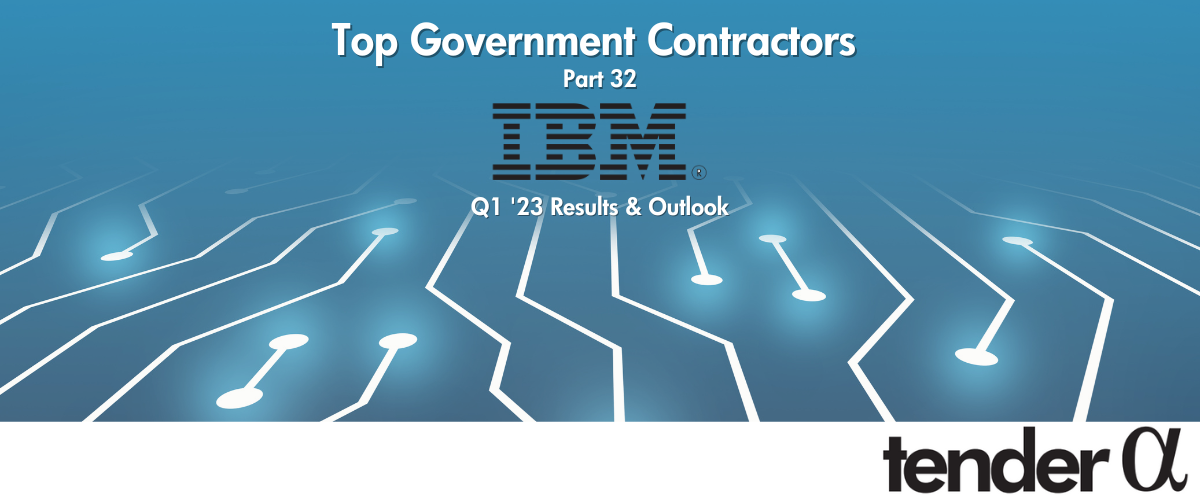It has been well documented that companies maintaining continued success in public procurement, also enjoy more predictability in their cash flow, and are generally more financially stable in insecure times. As discovered in our 'Government Receivables as a Stock Market Signal' white paper, winning government contracts is also likely to have a positive impact on a company’s stock price.
Therefore, we thought it would benefit our readers if we offered them detailed analyses of the financial results these major government contractors achieve.
It is now time for us to look again at a company we covered previously in this series. IBM recently reported its Q1 2023 results and below we will provide a brief analysis of the company’s performance in the first 3 months of the year.
Key Points:
* Q1 reported revenue up 0.4% Y/Y (2022 +5.5%). Constant currency growth of 4.4% Y/Y in Q1, with 3-5% increase expected in 2023;
* 2023 free cash flow target of $10.5 billion confirmed. Significant net debt at $41.1 billion;
* Software and Consulting segments to continue to drive 2023 growth as Infrastructure segment set to decline;
* Profitability skewed to H2 2023 as H1 impacted by restructuring. 2024 run-rate cost savings seen at $2 billion, or 7.2% of 2022 total costs;
* watsonx unveiled as the latest AI platform. IBM sees some 2.5% of its total workforce redundant thanks to AI.
IBM Q1 2023 Results Overview
We initially covered IBM's Q4 2022 results as part 7 of our Top Government Contractors series here. Below we will highlight the progress achieved by the company in Q1 of this year.
IBM reports results in three main segments, namely Software (includes Hybrid Platform & Solutions, Transaction Processing) at 41.5% of Q1 2023 revenues, Consulting (includes Business Transformation, Technology Consulting and Application Operations) at 34.8% and Infrastructure (includes Hybrid Infrastructure and Infrastructure Support) at 21.7% of Q1 2023 revenues:
Figure 1: IBM Q1 Results by Segment

Source: IBM Q1 2023 Results Press Release
Operational Overview
Software delivered 2.6% Y/Y revenue growth in Q1 (2022 +6.9%), with the gross profit margin improving 0.7% Y/Y to 79.5%. Growth was driven by cloud solutions at Red Hat.
Consulting was the best performing segment in Q1, with sales up 2.8% Y/Y (2022 +7.1%). The gross profit margin improved by 0.9% Y/Y to 25.2%. The best performing sub-segment was Application operations which provides cloud platform services.
Infrastructure was the only segment to record a revenue decline in Q1, down 3.8% Y/Y (2022 +7.8%). The weakness was driven by the Infrastructure Support sub-segment which works across hybrid cloud environments. Nevertheless, the gross profit margin improved by 1.2% Y/Y to 51.7%.
On a group level, sales increased 0.4% Y/Y in Q1 (2022 +5.5%). The top-line drag from dollar strength was quite significant, with Q1 constant currency revenue up 4.4% Y/Y. Free cash flow was $1.3 billion, up $0.1 billion Y/Y. Adjusted EPS was $1.36/share, down 3% Y/Y.
Figure 2: IBM Q1 Result Highlights

Source: IBM Q1 2023 Results Presentation
2023 Outlook
After the strong start of the year, IBM largely reiterated its 2023 outlook:
Revenue Growth: IBM expects constant currency revenue growth of 3-5%. At current foreign exchange rates, the company anticipates currency to be neutral to revenue growth (in 2022 currency was a negative contributor at 6.3%).
Free Cash Flow: The company expects about $10.5 billion in consolidated free cash flow, up more than $1 billion year to year.
Across divisions the outlook in constant currency is:
Software: Mid-single digit revenue increase. Pre-tax margin to expand by about 2% year-to-year;
Consulting: 6-8% revenue growth. Pre-tax margin up by at least 1%;
Infrastructure: Revenue down and low teens pre-tax margin (2022 14.8%);
Overall, IBM's pre-tax margin is expected to expand by 0.5% (2022: 16.2%), with profitability skewed to H2 2023:
In terms of profit, we now expect a little over 1/3 of our operating net income in the first half and just under 2/3 in the second half. This reflects a first half headwind from currency and workforce rebalancing dynamics, both of which flip to a tailwind in the second half. I mentioned the workforce rebalancing activity we have underway. Between the first and second quarter, the charge should be in the range of $300 million, maybe a little more. We still expect this action to pay back by the end of the year.
IBM also expects current cost-saving initiatives to results in a $2 billion run-rate reduction in costs by the end of 2024. The reduction represents some 7.2% of 2022 costs and would results in a 6.1% boost in gross profit.
Revenue resilience
The Software segment ended Q1 with $13.5 billion in annual recurring revenue (around 54% of trailing 12-month revenue). The increase was 7% Y/Y.
In Consulting the book-to-bill ratio was 1.07 for the past year.
Artificial Intelligence
On May 9 at its annual Think conference, IBM unveiled watsonx, its upcoming enterprise-ready AI and data platform, which consists of three components:
watsonx.ai studio for new foundation models, generative AI and machine learning;
watsonx.data fit-for-purpose store for the flexibility of a data lake and the performance of a data warehouse;
watsonx.governance toolkit, to enable AI workflows that are built with responsibility, transparency and explainability.
CEO Arvind Krishna has paused hiring as he believes some 7,800 employees could be made redundant thanks to AI. For reference, that is 30% of back office roles, or 2.5% of total employees.
Capital Structure
Over the course of Q1, net debt improved by $1 billion to $41.1 billion. Against a market capitalization of about $112 billion, IBM remains one of the most levered companies in our top government contractors list, notwithstanding that 17.9% of total debt is held in IBM Financing (the unit facilitates IBM clients’ acquisition of information technology systems, software and services through its financing solutions).
The consistent growth profile and strong free cash flow generation make the debt position manageable. Furthermore, the company's 4% 2042 USD bonds currently yield around 5.5% and are a good avenue for capital deployment.
Conclusion
While IBM did flag a slowdown in the North America market, Q1 developments were largely as expected and the company confirmed its 2023 outlook.
Going forward, currency should not be such a drag on reported numbers as it was in Q1. This will allow underlying growth dynamics to reach the company's USD-reported revenue.
IBM is also pursuing an ambitious cost-cutting program. Thus, 2024 should bring both top-and bottom-line improvements.
Considering the substantial business IBM does with federal agencies, monitoring the company’s public procurement activity remains a smart move that can provide key insights into IBM’s financial health.
To learn more about the ways in which TenderAlpha can provide you with insightful public procurement data, get in touch now!
This article was written by members of TenderAlpha's team and does not serve as a recommendation to buy IBM or any other stock. TenderAlpha is not receiving compensation for it and we have no business relationship with any company whose stock is mentioned in this article.
